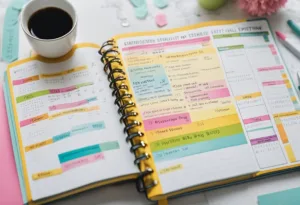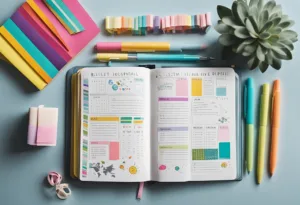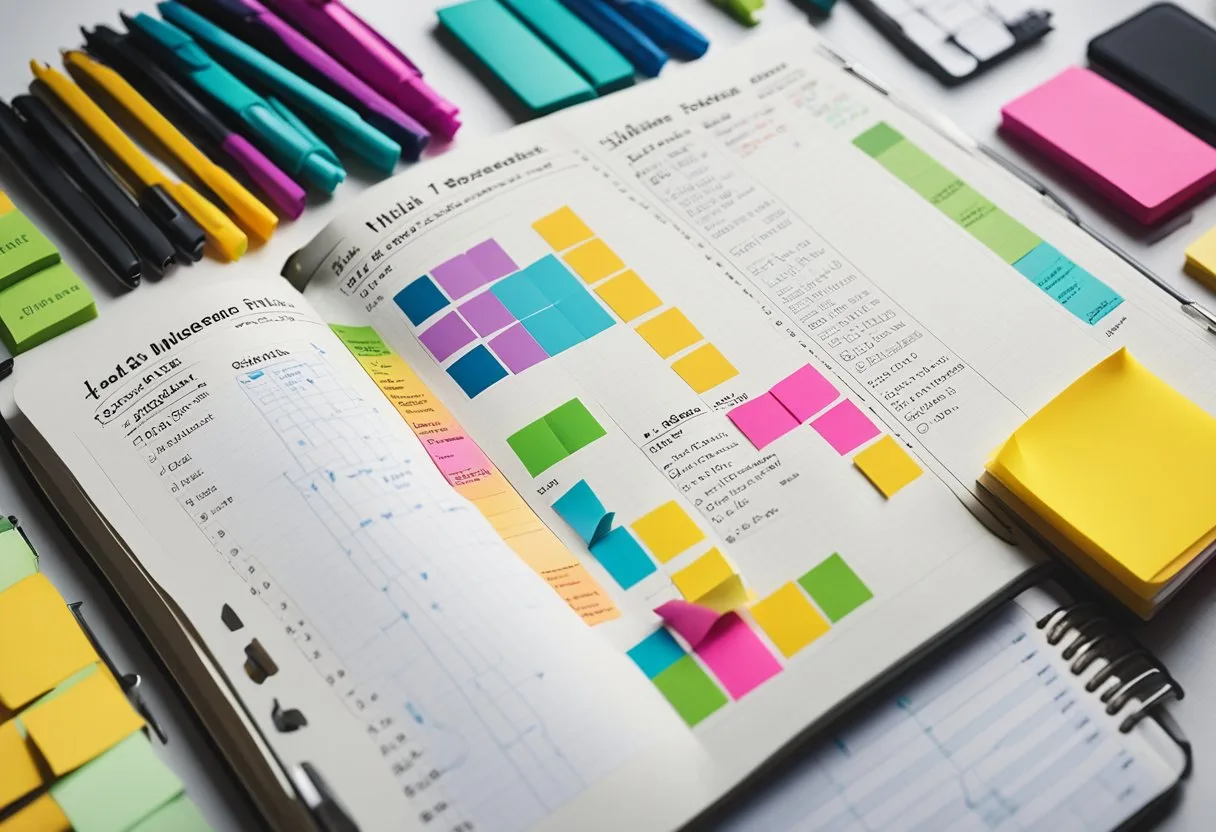Bullet journaling is a popular method of organizing tasks, goals, and ideas that has gained a lot of traction in recent years. A bullet journal is essentially a customizable planner that allows users to create unique layouts to suit their needs. One of the most important aspects of bullet journaling is the layout, as it can make or break the effectiveness of the journal.
There are countless ideas for bullet journal layouts, ranging from minimalist designs to elaborate spreads with intricate artwork. The key is to find a layout that works for the individual and helps them stay organized and on track. Some popular layout ideas include habit trackers, health trackers, weekly and monthly spreads, and mood trackers. Incorporating inspiring quotes or motivational messages can help keep users motivated and focused on their goals.
Bullet Journal Basics
Understanding the Bullet Journal System
Bullet journaling, also known as bujo, is a popular method of journaling that uses a pen and book or paper to create a personalized planner. The system was created by Ryder Carrol and is designed to be simple, flexible, and efficient.
The key to the bullet journal system is rapid logging, which involves using a set of symbols to quickly record tasks, events, and notes. These symbols are used to create an index page, which allows the user to quickly find information in their journal.
Choosing Your Bullet Journal Supplies
When it comes to bullet journaling, choosing the right supplies is important. The most important supply is the journal itself. It is recommended to choose a journal with high-quality paper to prevent bleeding and ghosting.
Other supplies include pens, markers, and stickers. It is recommended to use pens with a fine tip to allow for detailed writing and drawing. Creating a key is also an important step in setting up a bullet journal. A key is a set of symbols used to represent different types of information in the journal.
The bullet journal system is a flexible and customizable way to plan and organize your life. By understanding the basics and choosing the right supplies, anyone can create a personalized bullet journal that meets their needs.
Layout Design and Structure
Bullet journaling is a versatile system that allows for endless creativity and customization. The layout design and structure of a bullet journal are essential to its functionality and effectiveness. In this section, we will discuss how to set up key pages, create effective spreads, and incorporate creativity and aesthetics into your bullet journal.
Setting Up Your Key Pages
The key pages of a bullet journal are the backbone of the system. They provide structure and organization to your journal and allow you to track your progress and goals. The most common key pages include the future log, monthly layout, weekly spreads, and daily spreads.
The future log is a place to record upcoming events and tasks for the year. It is typically set up at the beginning of the journal and serves as a reference for planning ahead. The monthly layout is where you can see an overview of the month at a glance.
It usually includes a calendar and space for notes, goals, and habit trackers. Weekly spreads are used to plan out your week in detail, and daily spreads are where you can record your daily tasks, events, and notes.
When setting up your key pages, it is essential to consider your needs and preferences. You can customize your pages to fit your lifestyle and goals. For example, if you are a student, you may want to include a study schedule and a grade tracker. If you are focusing on self-care, you may want to include a gratitude log and a mood tracker.
Creating Effective Spreads
An effective spread is one that is easy to use and provides the necessary information at a glance. When creating your spreads, it is important to consider the layout, elements, and aesthetics.
Clean lines and a consistent layout can help make your spreads easy to read and use. Using headings, bullet points, and tables can also help organize information and make it easier to understand. Including elements such as habit trackers, calendars, and to-do lists can help you stay on track and achieve your goals.
Incorporating colors, themes, and aesthetics can also add a personal touch to your bullet journal. You can use different colors to highlight important information or create a theme for each month. Adding doodles, stickers, or washi tape can also make your journal more visually appealing and fun to use.
Incorporating Creativity and Aesthetics
Bullet journaling is not just about staying organized; it is also a way to express creativity and reflect on your life. Incorporating creativity and aesthetics into your bullet journal can make it a more enjoyable and fulfilling experience.
There are many ways to incorporate creativity and aesthetics into your bullet journal. You can experiment with different lettering styles, doodles, and illustrations. You can also use different materials such as watercolors, markers, or colored pencils. Adding inspirational quotes or personal reflections can also add meaning and depth to your journal.
The layout design and structure of a bullet journal are essential to its functionality and effectiveness. By setting up key pages, creating effective spreads, and incorporating creativity and aesthetics, you can create a journal that is both practical and personal.

35 Bullet Journal Layout Ideas
- Monthly Calendar Spread: Create a grid for the month, jotting down key dates and events. Use colors for a visually appealing layout, with a key for easy reference.
- Habit Tracker: Design a table to monitor daily habits. Assign a symbol or color for each habit, checking them off daily. This promotes consistency and self-accountability.
- Future Log: Dedicate a page to future events and plans. Divide it into sections for each upcoming month to easily visualize and plan ahead.
- Weekly Planner: Design a weekly layout with sections for each day, allowing detailed planning. Include space for to-do lists, priorities, and notes to stay organized.
- Meal Planning: Devote a section for weekly meal plans, noting recipes and grocery lists. This aids in healthier eating and efficient shopping.
- Gratitude Log: Create a daily log to jot down things you’re thankful for. This practice promotes mindfulness and a positive outlook.
- Book Tracker: Design a page to log books you’ve read or plan to read. Include a rating system and brief notes for each book.
- Expense Tracker: Keep a detailed record of your spending. Categorize expenses and set budgets to better manage finances.
- Brain Dump Page: When overwhelmed, dedicate a page to jotting down thoughts, ideas, or tasks to declutter your mind.
- Fitness Tracker: Monitor your exercise routine with a dedicated page. Include workout plans, achievements, and progress.
- Travel Itinerary: Plan your trips with a detailed itinerary. Include flights, accommodations, and activities for a smooth travel experience.
- Mood Tracker: Create a color-coded mood tracker for each day. Reflect on patterns and identify factors influencing your mood.
- Project Tracker: Use a spread to outline project goals, tasks, and deadlines. This aids in managing and completing projects efficiently.
- Quotes Page: Collect inspirational quotes or thoughts on a dedicated page to uplift and motivate yourself.
- Bucket List: Compile a list of things you want to achieve or experience. Break them down into smaller, achievable goals.
- Self-Care Routine: Outline a self-care routine, incorporating activities that promote mental and physical well-being.
- Language Learning Log: Track your progress in learning a new language. Include vocabulary, grammar rules, and practice sessions.
- Weather Tracker: Dedicate a page to record daily weather patterns. This helps in identifying weather trends over time.
- Monthly Review: Reflect on the past month’s achievements, challenges, and lessons. Use this insight for continuous personal growth.
- Gift Ideas Page: Maintain a list of potential gift ideas for friends and family. This ensures thoughtful and timely gift-giving.
- TV Show Tracker: Keep track of TV shows you’re watching, noting episodes and release dates. Stay updated on your favorite series.
- Birthday Tracker: Create a birthday calendar to remember and celebrate important dates. Include gift ideas and party planning notes.
- Sketch or Doodle Page: Unleash your creativity with a dedicated space for sketches, doodles, or art projects.
- Daily Affirmations: Write down positive affirmations to boost confidence and cultivate a positive mindset.
- Reflection Page: Set aside time to reflect on personal growth, achievements, and areas for improvement.
- Packing List: Before trips, create a checklist to ensure you don’t forget essentials. This minimizes travel stress.
- Goal Setting: Outline short-term and long-term goals, breaking them down into actionable steps. Track progress regularly.
- Social Media Calendar: Plan and schedule your social media posts to maintain consistency and engagement.
- Emergency Contacts: Compile a list of important contacts, including family, friends, and medical professionals.
- Seasonal Bucket List: Create a list of activities you want to do during each season, embracing the unique opportunities they offer.
- Pet Care Log: Record your pet’s feeding schedule, veterinary appointments, and other important details.
- Gardening Log: Keep track of your garden’s progress, planting schedules, and any issues that arise.
- Home Cleaning Schedule: Develop a cleaning routine with a weekly or monthly schedule for different tasks.
- Wish List: Maintain a list of items you wish to purchase or receive as gifts, helping you make informed buying decisions.
- Monthly Budget Review: Evaluate your financial goals and spending habits at the end of each month. Adjust your budget accordingly for better financial management.

Bullet Journal for Productivity and Goals
Bullet journaling is a popular method of tracking tasks, deadlines, appointments, and meetings. It is also an effective way to manage goals and personal growth. By using a bullet journal, one can create a customized planner that fits their unique needs and preferences.
Tracking Tasks and Deadlines
A bullet journal is an excellent tool for tracking tasks and deadlines. One can create a to-do list for each day, week, or month, and mark off tasks as they are completed. This helps to stay organized and on top of important tasks.
A bullet journal can be used to track long-term projects and deadlines. By breaking down a big project into smaller tasks and assigning deadlines to each, one can ensure that the project is completed on time.
Managing Goals and Personal Growth
A bullet journal is not just a planner, but also a tool for personal growth. One can use a bullet journal to manage their goals, both short-term and long-term. By creating a goals page, one can list their goals and track their progress towards achieving them. This helps to stay focused and motivated. A bullet journal can be used to track savings goals, financial goals, and other personal goals.
A bullet journal is an effective tool for managing tasks, deadlines, appointments, and meetings. It is also an excellent tool for managing goals and personal growth. By using a bullet journal, one can create a customized planner that fits their unique needs and preferences.
Personalization and Advanced Techniques
Bullet journaling is a highly customizable system that can be tailored to meet individual needs and preferences. With the right tools and techniques, you can create a journal that is not only functional but also visually appealing. In this section, we will discuss some advanced techniques that can help you take your bullet journaling to the next level.
Customizing Your Journal Layout
One of the best things about bullet journaling is that it allows you to create a journal that is uniquely yours. You can personalize your journal by using different templates, layouts, and designs. There are many bullet journal page ideas available online that you can use as inspiration for your own journal.
To get started, you can create a habit tracker to monitor your progress toward your goals. You can also include a mood tracker to keep track of your emotional well-being. If you love to travel, you can create a travel log to document your adventures. You can include a brain dump section to jot down ideas and thoughts that come to your mind.
Advanced Modules and Trackers
Bullet journaling is not just about keeping track of your daily tasks and appointments. With advanced modules and trackers, you can use your journal to improve your overall well-being. For instance, you can create a sleep tracker to monitor your sleep patterns and identify areas for improvement. You can also include a meal planner to help you plan healthy meals and stay on track with your diet.
There are many printables available online that can help you create custom modules and trackers for your journal. You can also create your own templates using software like Adobe Illustrator or Canva. The possibilities are endless when it comes to customizing your bullet journal.
Bullet journaling is a highly customizable system that can be tailored to meet individual needs and preferences. With the right tools and techniques, you can create a journal that is not only functional but also visually appealing. By customizing your journal layout and using advanced modules and trackers, you can take your bullet journaling to the next level and improve your overall well-being.
Frequently Asked Questions
What are some simple bullet journal layouts for beginners?
For beginners, it’s best to start with simple layouts. A popular layout is the daily log, which allows you to write down your tasks, events, and notes for the day. Another simple layout is the monthly log, which helps you keep track of important dates and upcoming events for the month.
How can one personalize their bullet journal as an adult?
Personalizing your bullet journal is a great way to make it unique and reflective of your personality. Some ways to personalize your bullet journal include using different colors, fonts, and stickers. You can also include pictures, quotes, and other items that inspire you.
Where can one find bullet journal layout templates?
There are many websites that offer bullet journal layout templates, such as Pinterest, Etsy, and Canva. You can also find templates in bullet journaling books and magazines.
What is the basic structure of a bullet journal?
The basic structure of a bullet journal includes an index, future log, monthly log, and daily log. The index is used to keep track of the content in your bullet journal, while the future log helps you plan for upcoming events. The monthly log is used to keep track of important dates and events for the month, and the daily log is used to write down your tasks, events, and notes for the day.
How can one organize their bullet journal for maximum productivity?
To organize your bullet journal for maximum productivity, it’s important to prioritize your tasks and set realistic goals. You can also use symbols and color-coding to help you quickly identify different types of tasks. It’s important to review your bullet journal regularly to ensure that you’re staying on track with your goals.
Are there any downloadable bullet journal layout PDFs available?
Yes, there are many downloadable bullet journal layout PDFs available online. Some popular websites that offer downloadable bullet journal layouts include Etsy, Pinterest, and Canva.




